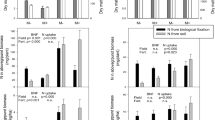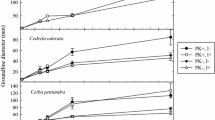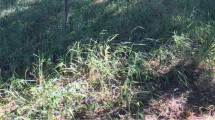Abstract
Growth and soil N supply in young Eucalyptus tereticornis stands at two sites in Kerala, India, were examined in response to cover cropping with three legume species (Pueraria phaseoloides, Stylosanthes hamata, and Mucuna bracteata). The effects of legume residues on soil N supply were investigated in a long-term (392 day) laboratory incubation using leaching micro-lysimeters. Residues from the eucalypt and legume species had different rates of net N release during the laboratory incubation. Net N release was significantly related to residue N concentration (R 2 =0.94), the C:N ratio (R 2 =0.91), the lignin:N ratio (R 2 =0.83), and the (lignin + soluble polyphenol):N ratio (R 2 =0.95). Nitrogen release rates declined in the order Mucuna > Pueraria > Eucalyptus > Stylosanthes. There was no net N release from Stylosanthes residues during the 392-day laboratory incubation, whereas Mucuna and Pueraria released N throughout the incubation period. Net N release from mixtures of legume and eucalypt residues was not additive in the early phase of the incubation, probably because eucalypt residues initially immobilized a portion of the legume-derived N in addition to the soil-derived N. Legume establishment had no significant effect on tree growth at one site (Kayampoovam), but resulted in depressed tree growth at the lower rainfall site (Punnala) at 18 months. There were no significant treatment effects on growth at Punnala after that time. Cover cropping with legumes during the early phase of forest plantation growth may be a useful mechanism to enhance soil N supply and optimize the synchrony between N supply and tree N uptake. Although these effects did not translate into improved plantation growth in the 3 years of this study, improved soil organic matter and N fertility may help ensure sustainable productivity over several rotations in the future. This study showed that the effect of legumes on N dynamics varies markedly with legume species. This, together with other factors (e.g. competition with trees, N fixation capacity), will be important in selecting suitable species for cover cropping in forest plantations.







Similar content being viewed by others
References
Aggangan RT, O’Connell AM, McGrath JF, Dell B (1999) The effects of Eucalyptus globulus Labill. leaf litter on C and N mineralization in soils from pasture and native forest. Soil Biol Biochem 31:1481–1487
Allen SE (1974) Chemical analysis of ecological materials. Blackwell Scientific, Oxford
Alley JL, Garrett HE, McGraw RL, Dwyer JP, Blanche CA (1999) Forage legumes as living mulches for trees in agroforestry practices—preliminary results. Agrofor Syst 44:281–291
Cadisch G, Giller K (2001) Soil organic matter management: the roles of residue quality in C sequestration and N supply. In: Rees RM, Ball BC, Campbell CD, Watson CA (eds) Sustainable management of soil organic matter. CABI, New York, pp 97–111
Cogliastro A, Gagnon D, Coderre D, Bhereur P (1990) Response of seven hardwood tree species to herbicide, rototilling and legume cover at two southern Quebec plantation sites. Can J For Res 20:1172–1182
Corbeels M, O’Connell AM, Grove TS, Mendham DS, Rance SJ (2003) Nitrogen release from eucalypt leaves and legume residues as influenced by their chemical quality and degree of contact with soil. Plant Soil 250:15–28
FAO (2001) Global forest resources assessment 2000. FAO Forestry Paper 140. Food and Agriculture Organization of the United Nations, Rome
Fox RH, Myers RJK, Vallis I (1990) The nitrogen mineralization rate of legume residues in soil as influenced by their polyphenol, lignin and nitrogen contents. Plant Soil 129:251–259
Frankenberger WT, Abdelmagid HM (1985) Kinetic parameters of nitrogen mineralization rates of leguminous intercrops incorporated into soils. Plant Soil 87:257–271
Gadgil RL (1983) Biological nitrogen fixation in forestry research and practice in Australia and New Zealand. In: Gordon JC, Wheeler CT (eds) Biological nitrogen fixation in forest ecosystems: foundations and applications. Nijhof, The Hague, pp 317–332
Handayanto E, Giller KE, Cadisch G (1997) Regulating N release from legume tree prunings by mixing residues of different quality. Soil Biol Biochem 29:1417–1426
Heffernan BJ (1985) A handbook of methods of inorganic chemical analysis for forest soils, foliage and water. CSIRO Division of Forest Research, Canberra
Little KM, Schumann AW, Noble AD (2002) Performance of a Eucalyptus grandis × E. camaldulensis hybrid clone as influenced by a cowpea cover-crop. For Ecol Manage 168:43–52
Mafongoya PL, Nair PKR, Dzowela BH (1998) Mineralization of nitrogen from decomposing leaves of multipurpose trees as affected by their chemical composition. Biol Fertil Soils 27:143–148
Malik RK, Green TH, Brown GF, Beyl CA, Sistani KR, Mays DA (2001) Biomass production of short-rotation bioenergy hardwood plantations affected by cover crops. Biomass Bioenergy 21:21–33
McIntyre BD, Gold CS, Kashaija IN, Ssali H, Night G, Bwamiki DP (2001) Effects of legume intercrops on soil-borne pests, biomass, nutrients and soil water in banana. Biol Fertil Soils 34:342–348
Nichols JD, Rosemeyer ME, Carpenter FL, Kettler J (2001) Intercropping legume trees with native timber trees rapidly restores cover to eroded tropical pasture without fertilization. For Ecol Manage 152:195–209
O’Connell AM, Grove TS, Mendham DS, Corbeels M, McMurtrie RF, Shammas K, Rance SJ (2004) Impacts of inter-rotation site management on nutrient stores and fluxes and growth of eucalypt plantations in south-western Australia. In: Nambiar EKS, Cossalter C (eds) Site management and productivity in tropical plantation forests—impact on soils and options for management over successive rotations. Centre for International Forestry Research, Bogor, Indonesia (in press)
Ofori F, Stern WR (1987) Cereal-legume intercropping systems. Adv Agron 41:41–90
Palm CA, Sanchez PA (1991) Nitrogen release from the leaves of some tropical legumes as affected by their lignin and polyphenol contents. Soil Biol Biochem 23:83–88
Sakala WD, Cadisch G, Giller KE (2000) Interactions between residues of maize and pigeonpea and mineral N fertilizers during decomposition and N mineralization. Soil Biol Biochem 32:679–688
Sankaran KV, Chacko KC, Pandalai RC, Kallarackal J, Somen CK, Sharma JK, Balagopalan M, Balasundaran M, Kumaraswamy S, Sankar S, Gilkes RJ, Grove TS, Mendham D, O’Connell AM (2000) Effects of site management on Eucalyptus plantations in the monsoonal tropics—Kerala, India. In: Nambiar EKS, Tiarks A, Cossalter C, Ranger J (eds) Site management and productivity in tropical plantation forests: a progress report. Center for International Forestry Research, Bogor, Indonesia, pp 51–60
Sankaran KV, Grove TS, Kumaraswamy S, Manju VS, Mendham DS, O’Connell AM (2004) Export of biomass and nutrients following harvest of eucalypt plantations in Kerala, India. J Sust For (in press)
Swift MJ, Heal OW, Anderson JM (1979) Decomposition in terrestrial ecosystems. Blackwell, Oxford
Tiessen H, Cuevas E, Chacon P (1994) The role of soil organic matter in sustaining soil fertility. Nature 371:783–785
Vanlauwe B, Diels J, Sanginga N, Merckx R (1997) Residue quality and decomposition: an unsteady relationship? In: Cadisch G, Giller KE (eds) Driven by nature: plant litter quality and decomposition. CAB International, Wallingford, pp 157–166
Acknowledgements
Funding for this work was provided by the Australian Centre for International Agricultural Research (ACIAR), CSIRO Forestry and Forest Products, and the Kerala Forest Research Institute (KFRI). We wish to thank the director of the KFRI, Dr J.K. Sharma for his encouragement, and other colleagues in the project, including Dr R.C. Pandalai, Mr K.C. Chacko and Dr S. Sankar. We also thank technical staff at KFRI for help in the field and laboratory, and at CSIRO (notably Shirley Snelling, Paul Damon, Tuyen Pham and George Wan) for assistance with laboratory analyses.
Author information
Authors and Affiliations
Corresponding author
Rights and permissions
About this article
Cite this article
Mendham, D.S., Kumaraswamy, S., Balasundaran, M. et al. Legume cover cropping effects on early growth and soil nitrogen supply in eucalypt plantations in south-western India. Biol Fertil Soils 39, 375–382 (2004). https://doi.org/10.1007/s00374-004-0719-5
Received:
Accepted:
Published:
Issue Date:
DOI: https://doi.org/10.1007/s00374-004-0719-5




